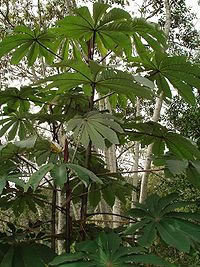Some of the plants of the tropical rainforest have mutually beneficial, or symbiotic, relationships with ants.
A symbiotic relationship occurs between Cecropia trees and Azteca ants in the Central and South American rainforests.
The umbrella-shaped Cecropia trees often colonize abandoned farmlands, disturbed roadsides and old clearings.
 They are small, quick-growing trees that increase in height by at least 6 feet (1.8m) each year and live for 20 years at most. The trunk and branches are hollow and divided by partitions, with thin patches in the outer wall.
They are small, quick-growing trees that increase in height by at least 6 feet (1.8m) each year and live for 20 years at most. The trunk and branches are hollow and divided by partitions, with thin patches in the outer wall.
Azteca ants bite their way into the trunk through these thin patches and establish colonies.
These ants introduce small plant-sucking insects into the chambers. The ants care for these small insects them, feeding on the sugary solution which the insects excrete.
The plant produces small outgrowths from the leaf bases, which are rich in food materials. The ants eat these outgrowths and feed them to their larvae.
Azteca ants are fierce, but do not sting.
They attack anyone who disturbs or tries to cut the Cecropia in which they live. They also bite through the tips of climbers, which could otherwise smother the Cecropia plant.
In Africa, the plant Barteria fistulosa provides shelter for large colonies of ants which, in turn, appear to defend it. This small tree grows up to 50 feet (15m) tall and is most abundant in old clearings and disturbed places, but also occurs in undisturbed forest. Ants occupy its horizontal branches, which are hollow.
The ants clear other plants from the area around the tree base by biting off their tips. They attack any animal that disturbs or breaks the tree. Their sting is painful, and its effects can last for a couple of days.
In Southeast Asia two members of the family Rubiaceae, Myrmecodia and Hydnophytum; a member of the family Asclepiadaceae, Dischidia; and two ferns, Phymatodes and Lecanopteris, provide ants with shelter, while the ants supply the plants with food.
All are epiphytes and, except for Dischidia, have swollen rhizomes, or stem bases, which contain hollows.
The hollows form whether or not ants are present.
However, these plants are almost always colonized by ants, which fill some of the cavities with debris, including insect remains.
The plants probably absorbs the nutrients from this debris as the debris decomposes.